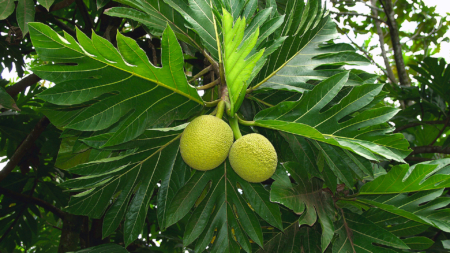An Ancient Food for the Modern World
Why we’re backing breadfruit.
Centuries before European navigators dreamed of a sea route to India and China, Austroneasian mariners set sail in wooden canoes to explore the vast Pacific. They carried only their knowledge of the water, wind and stars, and a few essentials, including breadfruit. It became a nourishing cornerstone of Hawaiian culture, where it’s called ‘ulu, and eventually an important subsistent food in equatorial regions around the world. However, breadfruit ripens very quickly once harvested, so it’s never had the commercial value of modern monocrops with longer shelf life, like banana and sugarcane. In Hawai‘i, imported foods have replaced traditional ones over the past several decades, and the number of breadfruit trees has steadily declined. But we want to change that because this ancient staple is an ideal crop for the modern world.
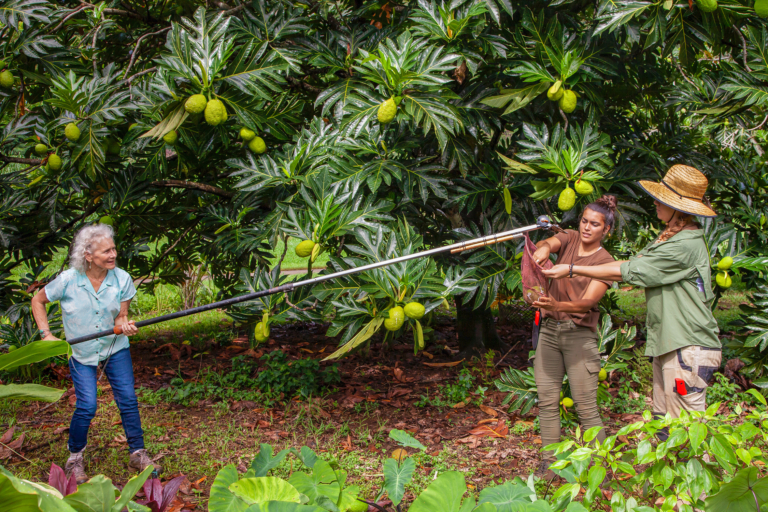
Dr. Diane Ragone in the Regenerative Organic Breadfruit Forest at the National Tropical Botanical Garden on Kaua‘i shows interns Saddie Vela (center) and Brittany Webster breadfruit harvesting techniques. Ragone was joined by chefs and breadfruit producers who schooled the interns on breadfruit varieties and how to assess quality and stages of ripeness—followed by a big lunch of breadfruit cooked multiple ways. Photo: Amy Kumler
“Breadfruit has nourished people for thousands of years and affords the opportunity to cultivate an abundance of nutritious and delicious food in ways that help, rather than harm, people and the planet,” says Dr. Diane Ragone. As the director of the Breadfruit Institute at the National Tropical Botanical Garden (NTBG) in Hawai‘i, she has devoted much of her working life to bringing breadfruit back. These graceful trees, with broad canopies and shiny dark-green leaves, flourish in tropical regions with high rates of hunger and malnutrition. Depending on the variety, each tree can yield up to 800 pounds per year, for as long as 50 years, feeding and sustaining farmers and local communities.
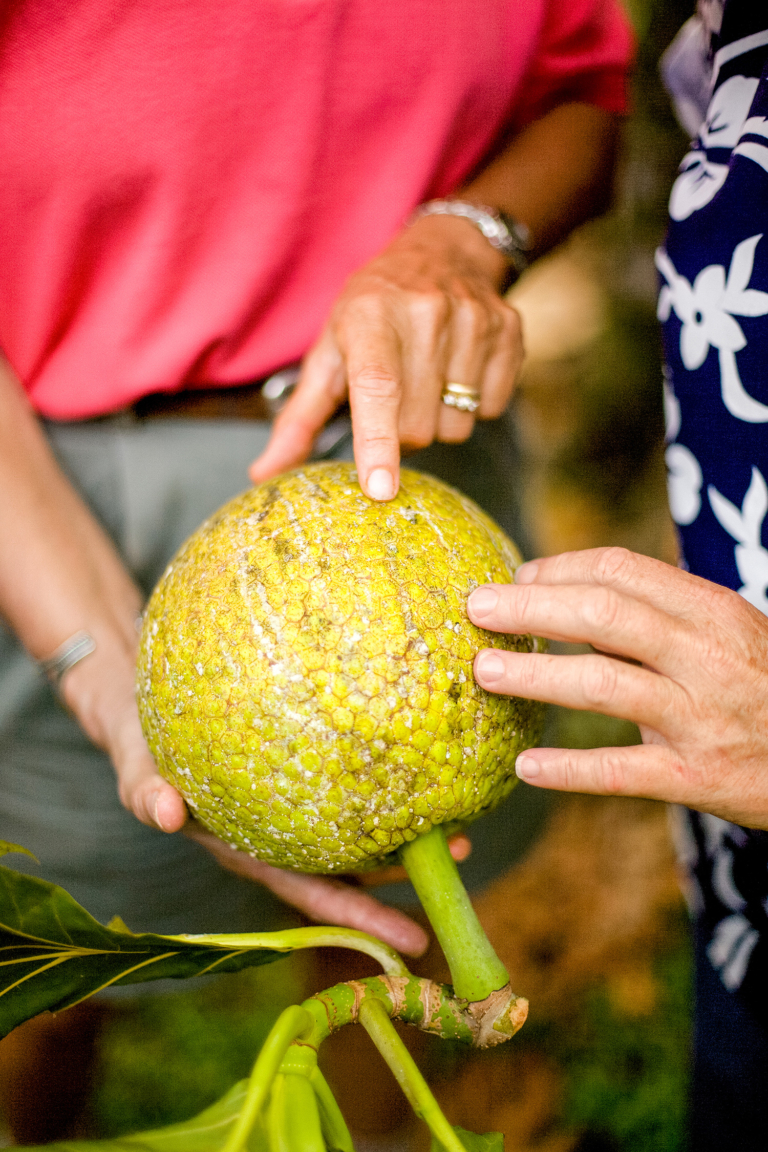
The Huero ninamu breadfruit, collected by Ragone in 1987 on Raiatea Island, French Polynesia, and now growing at the National Tropical Botanical Garden. It’s one of hundreds of varieties that she has gathered from the Pacific Islands. Photo: Jack Wolford
The fruit itself is yellow-green when mature, pebbly skinned and about the size of a melon. It smells like freshly baked bread when cooked, hence the name. A gluten-free starchy staple, its creamy white or yellow flesh is packed with complex carbohydrates and fiber and provides all nine essential amino acids, along with potassium, magnesium and other minerals and vitamins. The fresh fruit is delicious boiled, baked, pickled, roasted or steamed—and it makes a killer french fry.
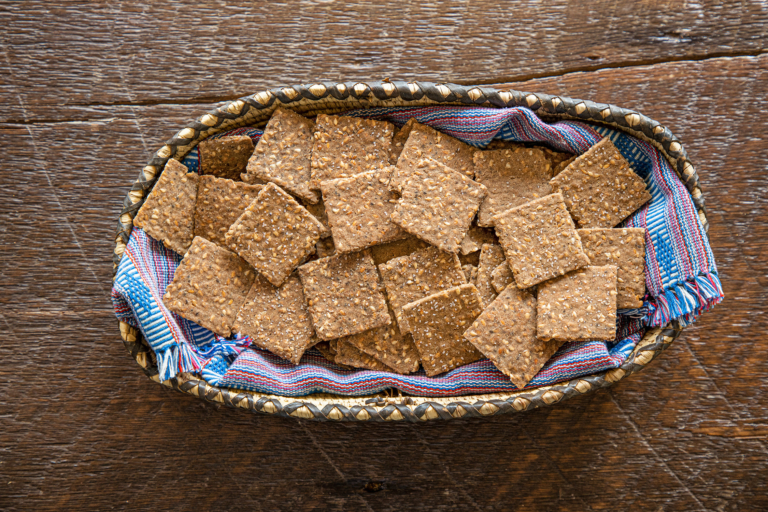
Honey Sesame Breadfruit Crackers. These crunchy, savory little crackers are the first of several breadfruit products coming from Patagonia Provisions breadfruit products. Photo: Amy Kumler
Breadfruit helps offset climate change, too. The trees are traditionally grown in Regenerative Organic “agroforests”—farms that combine plants of different heights, including trees, that thrive together. The opposite of monocrop plantation farming, which degrades topsoil, these older systems excel at drawing down carbon and building healthy soils that resist erosion and sop up rain.
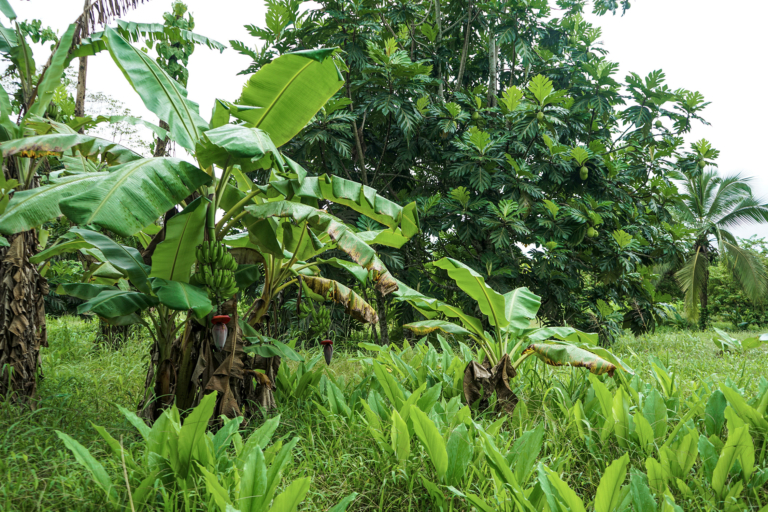
Look beyond the young banana trees in the foreground to see breadfruit trees—also just a few years old—in the agroforest at a Jungle Foods farm in Costa Rica. Photo: Gracie Cameron
For all these reasons, and because our planet needs this crop now more than ever, we’ve invested in the Breadfruit Institute to fund its research and revival of this lost food source. To deal with the fast ripening, we spent years collaborating with Ragone and others to build a reliable supply chain for shelf-stable breadfruit flour, useful in any number of foods.
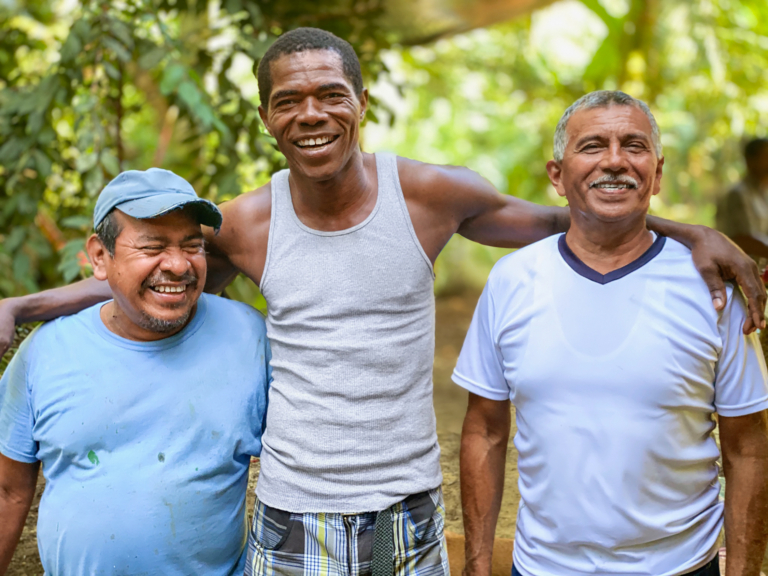
Jungle Foods breadfruit farmers (from left): Juan José Rosales, Mario Thompson Reechie and Angle Torrente Serrano. Photo: Paul Zink
After six years, we settled on partners in Costa Rica, one of many places where breadfruit now grows. Jungle Foods sources and buys the fruit from small (often backyard) agroforests, helping to bring financial stability to local farmers with a crop they can feed to their families, too. Earth University was an important early partner in figuring out how to wash, peel and slice mountains of fresh fruit, and it continues to help us with research. Now the processing is overseen by Jungle Foods, including dehydrating and milling the fruit into flour.
Last fall, we finally made our first food with that flour: crunchy, sweet-savory Patagonia Provisions Honey Sesame Breadfruit Crackers. With this project, and more to come, we salute Ragone, NTBG and all the family growers who’ve kept the breadfruit tradition alive for generations.
Saving a forgotten fruit
As industrial agriculture edged out breadfruit, small local growers kept the trees going, cherishing them as a reliable food source and rich part of their heritage. But the trees were at risk of disappearing, along with ancient, irreplaceable knowledge. In the early 1980s, Dr. Diane Ragone, then a graduate student in Honolulu, began gathering breadfruit samples, customs and traditions across the Pacific. Thanks to her efforts to preserve this legacy, 150 cultivars are now preserved at the National Tropical Botanical Garden in Hawai‘i. They’re used to propagate vigorous saplings, which have been sent to more than 40 different tropical countries.
To find Honey Sesame Breadfruit Crackers and an expanding collection of responsibly sourced foods, each with a story to tell, visit patagoniaprovisions.com.
This story was first published in the Patagonia Spring 2021 journal.
